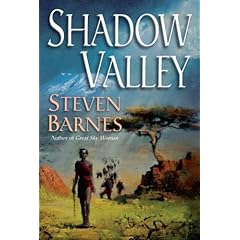Remember, stories are not reality. They are a shared dream, a pretense, a shadow-play. The reader or viewer makes a contract with the writer or filmmaker: I will suspend my disbelief, and you will entertain me. Now understand, we’re not just talking about suspension of disbelief in the sense of “wow! A 50-foot monkey! How am I supposed to believe in that?”
It’s more basic than that. In the case of a movie, you are asking people to sit in a darkened auditorium and pretend that light images projected against a piece of linen can actually frighten them, transport them, intoxicate them. In the case of a stage play, you are asking people to believe that actors on a nearly-bare stage actually have four walls around them, or that three soldiers represent a multitude. In the case of a book or story, you are asking people to translate bits of ink on paper into extreme emotional experience.
And you know something? The audience wants to believe. The reader wants to be entertained. When they go to the theater, slip in that DVD or open that book, they are ready and willing to be seduced, to go into that mild form of insanity that is optimally receptive to story. They want it.
All you have to do is seduce them. My guess is that everyone who is reading this has seduced someone at some point in your life. What did you do? If you can translate this skill over into the arena of writing, you have a terrific advantage over someone who doesn’t see the parallels.
1) You catch their attention. We can assume that the reader has picked up your book, the viewer seen the advertising for the movie. This is roughly equivalent to meeting a delicious lady or gentleman and catching their eye.
2) You begin a conversation. Make ‘em laugh. Make ‘em think. Create an emotional change of some kind. You engage with them. There are websites committed to the application of advanced psychological tricks to seduction. Yeah, it works, but don’t ask me how I know. Ahem. In writing or onscreen, this means that you create a world they recognize, or a recognizable human being, or a set of actions that will trigger recognition and/or empathy in your audience. They believe and understand what they are seeing, or are sufficiently engaged that a deliberate oddness catches their attention. They say to themselves: “what is this? Who is this? What will happen next?” The best way to do this is to engage one of the three most basic motivations: survival, sex, or power.
3) You determine a potential partner's needs, and suggest that you can satisfy them. If your audience is interested in horror, you give them the sense of the uncanny. If they like intellectual puzzles, you set it up with clever word-play. If you are writing an adventure piece, you create a believable character, and begin to suggest something odd and potentially threatening in their world.
4) If possible, take your Potential Partner's balance a bit. Take them to a new place. Take them dancing. Get ‘em drunk. Make them laugh HARD. Evoke strong emotions with music, food, travel, etc. The conscious mind shuts down a bit, and the older, more primitive neural circuitry is exposed. You want access to that limbic system that wants to touch, not the programmed mind that is filled with reasons not-to. In storytelling, you want to evoke strong, primal emotions: fear, lust, anger, pain, anxiety, uncertainty, etc.
5) Convince the PP that you are on the same page. Achieve rapport. Now, all of the above steps are perfectly ethical—if you are sincere. All of them can also be misused for sexual exploitation. You can exploit readers as well, seducing them into dropping their guard, and then twisting their emotions or taking them sideways into an unexpected and unpleasant experience.
6) Break the wall. At some point, touching must begin. In a story, you have achieved rapport, convinced the reader you have created a real world, and then knock 'em sideways a bit.
7) Increase the pace of engagement. Events begin to accelerate once you have achieved rapport. In physical seduction this is a phase of kissing and hugging, etc. In a story, you are hitting the characters with broader and/or deeper waves of experience and opportunity.
8) Shift rhythms. You want to change the rhythm of engagement as much as possible without breaking rapport. Teasing and taunting a bit, playing games, doing the unexpected. This continues to take your PP off-balance. Done properly and in a giving spirit, you are giving your reader what they want…but not the way they expected it. They will be delighted with the creativity and sensitivity necessary to pull this off.
9) Keep your word. A story, movie or seduction is a contract. You have expressed to your target, audience, or partner that you are a particular type of writer/person. That you can be relied upon for a particular type of experience, and have a particular intent. If you keep your promise, the reader/seductee can be an educated consumer, deciding if this is the experience they want. If you provide what you imply, they will be satisfied with the experience, and come back for more.
10) Be yourself. And this is so incredibly key. You can be clever enough to write something popular, or clever enough to use “lines” and, basically, fraud to get a man or woman into bed. But the relationship thus gained ain’t worth it, and cannot be sustained. Be yourself. Tell your story. Communicate who you really are. Write to an audience like you, and set your seductive focus on a person who is your equal. Don’t play games with this. What we want here is enlightened selfishness: I want to do business with you again. I want you to read my next book, I want you to answer my next phone call.
##
I’m kidding just a bit here, but you know? You may have a very different approach to writing, or to romancing a sexual partner. Great. All I’m really suggesting is that you experiment with making the two activities more alike. You may enjoy the result.
Thursday, December 14, 2006
Seducing the Audience
Posted by
Steven Barnes
at
10:18 AM
![]()
Subscribe to:
Post Comments (Atom)







No comments:
Post a Comment